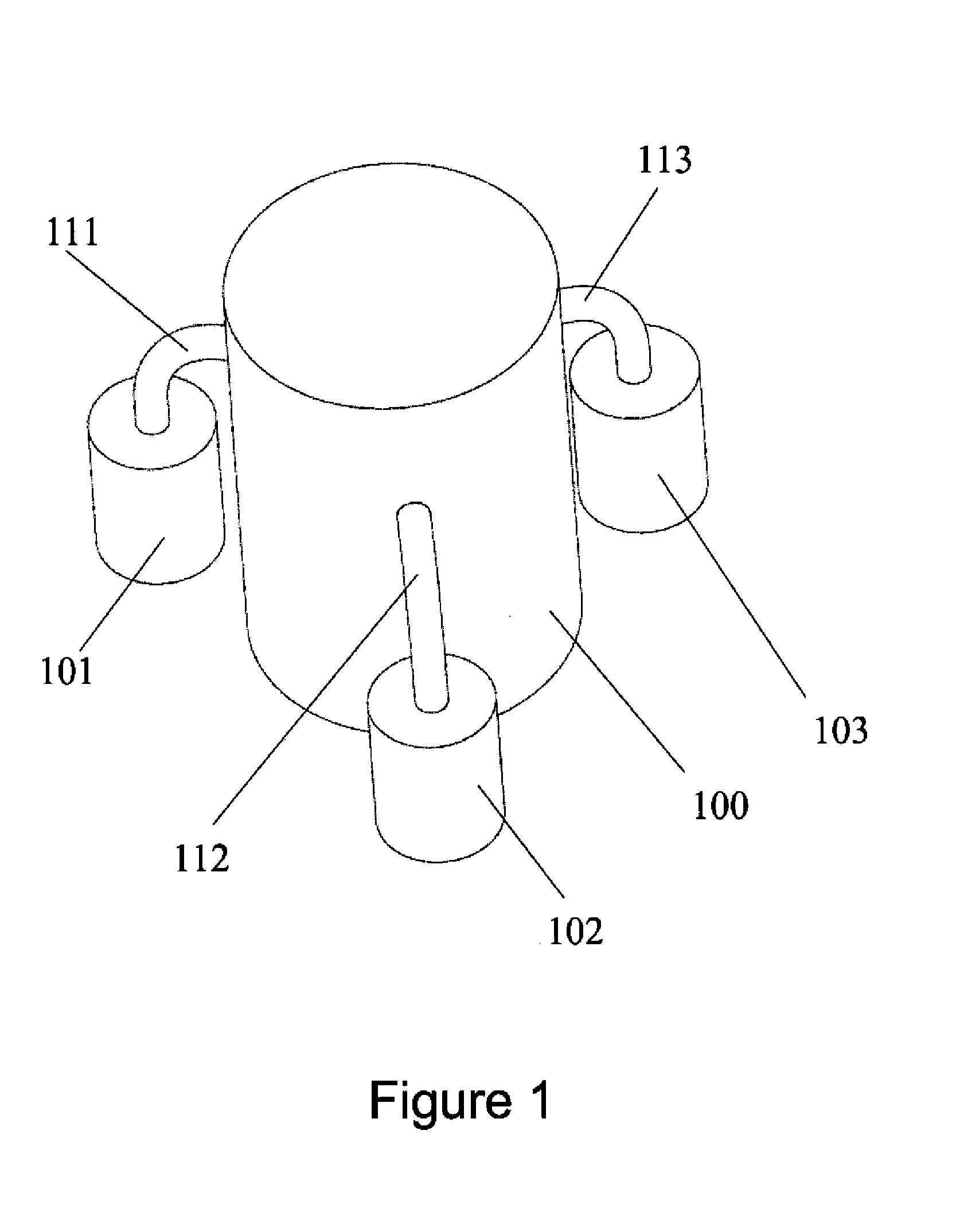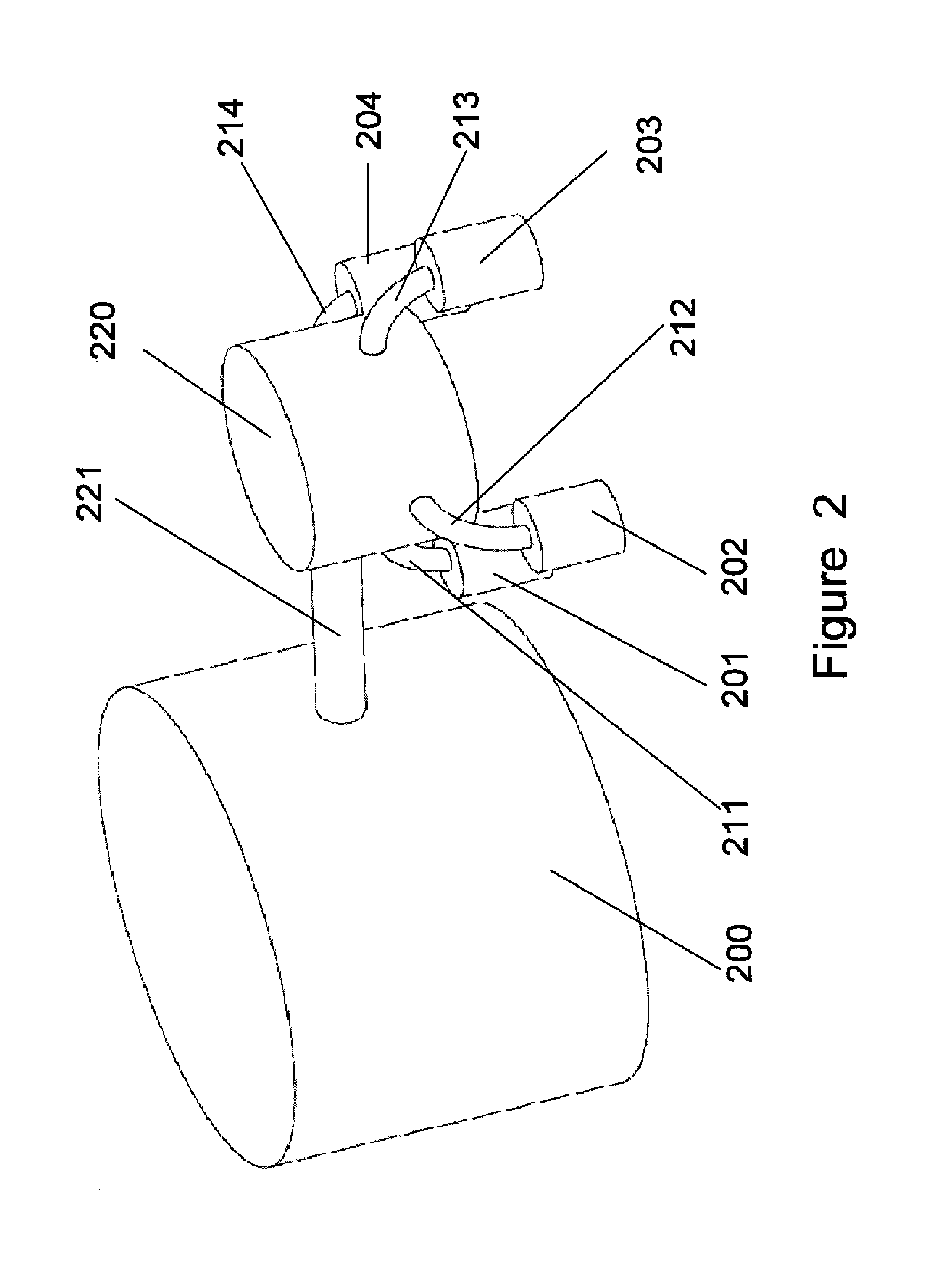[0025]Further, a sealing element will be provided to ensure a sealing effect of the connection between the sample vessel and the connection element, so as to avoid material leak. The sealing element may be made from elastic material, “O” shape rings or any other sealing element known by the art. Another method to enhance the sealing effect is to design connecting parts of the sample vessel and the connection element in shapes or forms benefiting sealing. For example, the connecting parts of the sample vessel and the connection element may be configured to linearly contact with each other. In one embodiment, referring to FIG. 9, the sample vessel 900 has a outlet 901 configured in a round shape, and the connection element has an engaging port 911 configured in a cone-like shape for engaging with the round outlet 901 of the sample vessel. In
assembly, a receiving room 902 in the sample vessel 900 communicates with a passageway 912 in the connection element 910. The outlet 901 and the engaging port 911 are brought into contact with each other at two linear contact portions, thus a better sealing effect can be achieved. In other embodiments, maybe the port of the sample vessel is cone-shaped and the engaging port of the connection element is in round shape; or maybe both the port of the sample vessel and the engaging port of the connection element are cone-shaped or in round shape. The sample vessel and the connection element alternatively may be configured into other shapes to achieve linear contact therebetween.
[0026]The sample vessel for storing samples can be any container, collector or any device with a function for storing known by the art. The present invention also discloses a
syringe type sample vessel. Referring to FIG. 10, a sample vessel 150 comprises a body 152 defining a receiving room 153 for storing samples. The body 152 has an end defining a inlet 154 communicating with the receiving room 153 and another end engaging with a compress element 155. The compress element can enter the receiving room 153 to push a sample stored in the receiving room 153 out of the receiving room 153 through the inlet 154. Moreover, a sealing element can be provided between the compress element and the receiving room, so as to prevent leakiness while the compress element is pushed into the receiving room. The sealing element can be “O” shape ring, etc, and the compress element can be driven by motor, cylinder,
piston, etc.
[0035]Further, the high throughput processing system with the materials-inputting subsystem in accordance with the present invention can further comprise an
environmental temperature adjusting chamber, which can adjust the
environmental temperature to increase fluidity of a sample with a relatively high viscidity. In one embodiment, referring to FIGS. 16 and 17, a temperature controlled chamber 20 comprises a body defining an inner surface 21 and an outer surface 22. There is a receiving room defined within the inner surface 21. An inner
temperature control element 23 is provided on the inner surface 21 and an outer
temperature control element 24 is provided on the out surface 22. Between the inner surface 21 and the outer surface 22, an insulator 25 is provided. The temperature change between the inner surface 21 and the outer surface 22 is minimized to reduce the rate of heat loss or
gain to or from the inside of the chamber 20. The insulator may include one or more
layers, and the insulator may be any insulating material, vacuum, or combination thereof. A multi-layer insulator may include multi-
layers of insulating material or
layers of insulating materials and vacuums in combination. For example, an insulator comprises three layers, wherein a top layer and a bottom layer are formed from different insulating materials, and the middle layer is formed by vacuum. There is no restriction as to the number of the layers of the insulator. Optionally, one or more reflective shields may be arranged between the inner surface 205 and the outer surface 215 of the chamber 200 to minimize heat loss through
radiation.
[0042]As will be evident to those skilled in the relevant art, a
computer software program of the present invention may be executed by being loaded into a system memory and / or a memory storage device through one of input devices. On the other hand, all or portions of the
software program may also reside in a read-only memory or similar device of memory storage device, such devices not requiring that the
software program first be loaded through input devices. It will be understood by those skilled in the relevant art that the
software program or portions of it may be loaded by a processor in a known manner into a system memory or a cache memory or both, as advantageous for execution and used to perform a random sampling
simulation.
[0060]In an embodiment, referring to FIG. 19, a movable first connection element 450 (different embodiments can refer to the above corresponding disclosure of the present invention) directly move into a sample vessel stored with a cleaning material. The cleaning material (not shown) enters the first connection element through a docking port 452 along an arrow direction as shown in the FIG. 19, and cleans the periphery of the docking port 452 at the same time. Then the cleaning material enters a processing apparatus 460 through a
pipe 456 connected therebetween to begin cleaning the processing apparatus. Finally, the used cleaning material is expelled out of the processing apparatus through a docking port 472 of a second movable connection element, which is connected to the processing apparatus through a
pipe 476 connected there between, and thus cleaning of the system is finished. At the same time, the docking port of the second movable connection element had better move to a position rightly above a bucket 480 for collecting used materials, so as to collect the used cleaning material. A shape of the bucket 480 is preferably designed the same or familiar as shown in the figures, so as to clean the periphery 473 of the docking port 472 of the second movable connection element 470 during expelling of the used cleaning material. In another embodiment, the used cleaning material can be expelled through an outlet of the materials-processing apparatus and collected by the collecting subsystem. In another embodiment, the cleaning material can be inputted through the fixed connection element, detail description for which can refer to the above corresponding disclosure. So with the cleaning method in accordance with the present invention, the processing system can continuously proceeding the material
sample processing and the system cleaning without interruption, just like continuously proceeding batches of
sample processing with some batches of samples are replaced by the cleaning material. Thus an efficiency of the system is increased.
[0061]Compare to the prior art, the inputting subsystem of the processing system with 16 sample vessels for example, in accordance with the present invention, can continuously input 120 groups each comprising two samples, or 560 groups each comprising three samples into the processing apparatus, if proper a connection manner as disclosed in the present invention is chosen (there will be more embodiments for the groups of the sample vessels based on the permutation and combination theory). Since there is no restriction as to the number of the sample vessels, there is no restriction as to the number of the groups for inputting, that means the operator can decide the number of the sample vessels. Therefore, the continuous inputting can increase the efficiency of the system in one hand and decrease the risk of mistakes of manual operation in the other hand, and the high throughput inputting brings high throughput material processing of the system. Moreover, with the combination of the collecting subsystem in accordance with the present invention, the samples processed can be collected orderly and continuously, so as to further increase the efficiency of the system and overcome the deficit of the artificially interval samples collecting of the prior art. Finally, with the combination of the cleaning method in accordance with the present invention, the cleaning of the system can proceed next to a sample process with no interruption, so as to overcome the deficits of the prior art in cleaning aspect and further increase the efficiency of the system.
 Login to View More
Login to View More  Login to View More
Login to View More 


